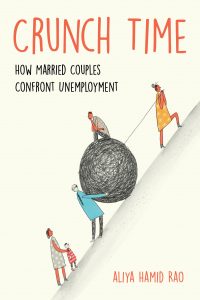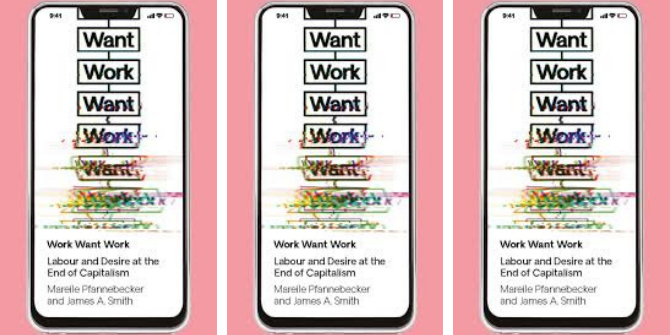We speak to Dr Aliya Hamid Rao about her new book Crunch Time: How Married Couples Confront Unemployment, which draws on interviews with college-educated unemployed individuals and their spouses, alongside family observations with some of the participants, to explore how men and women have starkly different experiences of unemployment. This interview discusses how gender is central to the ways married heterosexual couples react to and make sense of job loss and reflects on what the findings of Crunch Time suggest about the impact of the COVID-19 pandemic.
Q&A with Dr Aliya Hamid Rao, author of Crunch Time: How Married Couples Confront Unemployment. University of California Press. 2020.
 Q: In Crunch Time, you explore experiences of job loss for college-educated unemployed men and women and their spouses. What led you to focus on middle-class professionals for your study?
Q: In Crunch Time, you explore experiences of job loss for college-educated unemployed men and women and their spouses. What led you to focus on middle-class professionals for your study?
Unemployment has been a persistent feature of societies since industrialisation. What’s new about unemployment in the current era, though, is that it’s now pervasive for workers of all social classes. Of course, the biggest toll remains on vulnerable workers, such as those with lower educational credentials, but for the first time we are seeing that unemployment has become a widespread experience for highly educated professionals whose jobs had previously been far less touched by any tumults in the labour market. Basically, when it comes to unemployment, those in the professional middle class are an understudied population who are more likely now than ever before to experience unemployment. This was a key motivation for why I focused on them empirically.
Q: Crunch Time shows that the uncertainty of unemployment typically led the married heterosexual couples in your study to fall back on cultural scripts that privilege traditional gender roles. How did this produce different experiences of unemployment for your male and female participants?
For men in my study, unemployment was framed as an urgent problem that needed to be resolved as quickly as possible. The way that families of unemployed men went about trying to resolve it was by directing resources – such as time, money, space and emotions – to help men get re-employed. In families of unemployed women, their unemployment was downplayed. Even when women had earned half or more of the household income, these couples framed the income lost as ‘well, that was extra and nice to have, but we’re fine without it’. Objectively this did not square with how it was these women’s incomes that had allowed the families to live their relatively affluent lifestyles – such as living in wealthy neighbourhoods, taking international vacations etc. These families thought that women’s re-employment would be nice when it happened, but there was no rush. So, resources were not directed to help women job search. Their job-searching was in the background, squeezed in between things like household chores.

Q: You underscore that the gendered expectations of these cultural scripts are also related to raced and classed ideals. How did these cultural scripts typically reflect White middle-class norms and experiences?
I think that cultural scripts around intensive mothering, around privileging the male breadwinner/female carer model of family life, really reflect White middle-class norms. There’s fantastic research from scholars about how, for instance, Black mothers in the professional middle class do not subscribe to these norms. Given different histories for Black mothers, as scholars have shown (Dawn Marie Dow’s recent book, Mothering While Black, is excellent on this), ideologies integrating paid work with mothering are much more powerful. And in the book, you see hints of this with some of my participants, for instance Gina Forrester, as well. I would be curious to see how different ideologies about mothering and ideal family structures shape responses to unemployment – amongst different racial groups, family structures and so on. I think that would be an important area for future research.
In Crunch Time, however, even in these dual-earner families, the male breadwinner/female carer model exerted a powerful influence such that men’s unemployment was really seen as very disruptive to the family and something that had to be explained away. Whereas women’s unemployment was just much more congruent with gendered expectations of what women ought to be doing first and foremost (caring for children and their homes). To me, this traditionalism in these families was pretty stark.
Q: You look at how much unemployed men and women engage in housework. What were the patterns you observed?
A dominant pattern that I observed with unemployed men was that even though they were unemployed (for months, even years, and while their wives were employed), their unemployment did not mean a significant reorganisation of housework. Unemployed men did do more than they had prior to losing their jobs – for instance, more of the picking up and dropping off kids from their various activities – but really the housework remained the wife’s domain. Wives continued to be the organisers. For instance, in the family of one of the unemployed men I interviewed, he did the grocery shopping, but his wife would make the grocery list because she was the one still doing the meal planning and cooking. So the discrepancy was quite enormous. And it was rationalised really in two ways by the men I studied: 1) my job is to search for a job, so housework is not my responsibility; and 2) I’m naturally incapable of housework.

With women, what I saw was that they did more housework. In accordance with prior quantitative research, I found that women had typically done more than their husbands when it came to housework and childcare and they amped this up even more after they lost their jobs. Through my study, however, I am able to explain why women do even more. For many women, the domestic realm became a source of respite – they could embrace the culturally valued identity of ‘stay at home mother’ rather than ‘unemployed worker’. For these women, however, the allure of the domestic often waned after several months and they itched to get back into paid work. For others, they felt that since they were unemployed and no longer contributing economically to the household, they really needed to contribute by doing (almost) all of the housework. This was noticeably different to how unemployed men responded.
Q: Did any of your participants seek to actively dismantle gender norms?
I don’t know that any of them actively sought to dismantle gender norms but certainly some did behave in more gender egalitarian ways. For instance, while the dominant response amongst unemployed men was to not excessively amp up their contribution to housework, some men did do much more housework and saw it as incumbent on themselves to do that. Responses to housework are important because the division of paid and unpaid work is a litmus test of gender equality. These were often men who, even before losing their jobs, had done more housework anyway and saw it as important to do so. Their job loss seemed to solidify this resolve.
Q: Crunch Time shows that the home is a really important space for thinking about experiences of unemployment. How did your participants relate to the space of the home following job loss? Do we need to give more attention to this space, given the rise in both home-working and unemployment due to the COVID-19 pandemic?
Yes, I think the space of the home and how it’s used is fascinating. It’s interesting because the home is often considered women’s domain. But what I saw happen was that because unemployed men’s job loss was seen as such a grave problem and their job-searching as so important, families created home offices or other such spaces for men to job search from. When they had home offices, they upgraded those with new hardware, software equipment and even furniture. So, while these families are experiencing unemployment, they are nonetheless spending money to upgrade home offices to help men job search. This did not happen with unemployed women who often job searched from anywhere – papers and computer spread out on the kitchen table, dining room, on their kids’ desks or job-searching while they sat at the bleachers at their kids’ extra-curricular events.
I think how the space of the home is utilised, and who gets prioritised, is definitely important as homeworking and unemployment due to COVID-19 continue. With homeworking, I’ve been seeing lots of news articles about how men often have dedicated spaces to work from, while women are shutting themselves up in their bathrooms and so on in order to be able to attend Zoom meetings undisturbed. In academia (where researchers experience a gendered ‘pandemic penalty’), as many of us are teaching online, it seems to me that it’s often the male academics who are going all out with hooking up multiple screens, laptops, to seemingly professional green screens, ring lights and so on for their lecture recordings or synchronous remote teaching. For the researchers studying homeworking during the pandemic, I’d be really curious to see what their findings are in terms of how the space of the home is reorganised during this time.

Q: Given the findings of Crunch Time, is increased unemployment due to the COVID-19 pandemic likely to have different impacts on men and women? What actions could we take to mitigate this?
The economic fallout of the pandemic is already gendered in terms of who is losing jobs – and the new thing is that this is the first economic downturn where women are losing more jobs than men (The Great Recession of 2008, for instance, was also dubbed the ‘Mancession’ since so many of the jobs lost were in industries dominated by men, such as construction). But we’re also seeing a resurgence of mothers being pushed to quit their jobs during lockdowns in various countries as childcare centres and schools shut and kids were at home and had to be looked after by someone. I think what we’ll see is that amongst the unemployed, men’s job-searching will be privileged (as the findings from Crunch Time suggest), and they will be afforded resources to focus on job-searching while women will likely be handling a lot of things – with their job search being just one of them. This is not because women would prefer it this way, but simply because the buck seems to stop with them for a lot of things, including managing childcare, housework and generally keeping the house together. When I think about my research, I’m actually reminded a lot about what the frontier writer, Willa Cather, wrote, describing a woman who was experiencing downward mobility in the early twentieth century: ‘her lightness cost her something.’ This idea of performing a lightness, producing a sense of safety, a cosy home, whilst dealing with significant economic setbacks, has often fallen on women, and certainly my research suggests it will continue to.
Some actions we can take to mitigate this include providing affordable and quality childcare. In my study, the women turned to the domestic realm simply because childcare was so expensive that they said financially it made no sense to pay for exorbitant daycare centres when they were unemployed (men did not say this). So the lack of childcare was a big factor that shaped how women in my study responded to unemployment. I think the second thing is really that employment simply is not stable enough to build a life around. When unemployment seeps into the lives of some of the most privileged workers and impacts them repeatedly, that’s a pretty good sign that how paid work is organised is broken. I don’t think the solution to this is policies like extending unemployment insurance benefits or even increasing the amount. I think it has to be a policy that recognises just how terribly insecure employment now is and tackles that head on. I think the policy that can best do that is probably Universal Basic Income.
Note: This interview gives the views of the author, and not the position of the LSE Review of Books blog, or of the London School of Economics. The interview was conducted by Dr Rosemary Deller, Managing Editor of the LSE Review of Books blog.
Image One Credit: Photo by Markus Winkler on Unsplash.
Image Two Credit: Photo by Charles Deluvio on Unsplash.
Image Three Credit: Photo by Charles Deluvio on Unsplash.







